Short Answers
- What is ‘Depreciation’?
Ans. Depreciation is the decrease in the value of fixed assets caused by wear and tear over time. These fixed assets could be anything from furniture to machinery to a building. It is important to note that such fixed assets do not include land, as the value of land increases over time.
2. State briefly the need for providing depreciation.
Ans. The following are the requirements for providing depreciation:
- The value of fixed assets depreciates over time as a result of wear and tear, reducing the asset’s capacity. As a result, depreciation must be recorded in order to reflect such an effect on the books of account.
- Depreciation depicts the true financial position of the business because it eliminates the possibility of assets being overvalued.
- Depreciation meets the need and requirements of tax regulations and other compliances.
- Depreciation allows the business to meet the revenue matching principles, which require that the expenses incurred by the business be incurred in the same period that the income is recognized.
3. What are the causes of depreciation?
Ans. The following are the causes of depreciation:
- Some current assets have a finite life after which they become perishable. Inventory is an example of such an asset.
- Because fixed assets wear and tear over time, it is necessary to record the reduction in the cost of such fixed assets.
- As new technological innovations emerge, fixed assets such as equipment and machinery become obsolete. This must be properly recorded in the books of account, and depreciation accomplishes this.
- The use of some assets depletes over time, and this depletion of assets is recorded using accounting depreciation. Gas and oil reservoirs are examples of such assets.
4. Explain basic factors affecting the amount of depreciation.
Ans. The following are the primary factors that influence the amount of depreciation:
- Depreciable cost – This is the cost that remains after deducting both the residual cost and the various costs of the asset. The total depreciation should be equal to the total depreciation charged over the useful life of the asset.
- Net residual value – This is the value of the asset’s sales after its useful life has ended. It is calculated by deducting all expenses incurred during the disposal of the asset.
- Various Costs of the Asset – Aside from the basic purchase cost of the asset, an asset will incur various costs. These expenses can take the form of transportation, commission fees, insurance premiums, and so on. These are the expenses incurred in order to restore the asset to working order.
- Estimation of useful life – The useful life of any asset is defined as its actual commercial life. As a result, the concept of the asset’s physical life is excluded because it considers the fact that the asset will continue to sustain even after its useful life has ended, which may not be of commercial productivity for the business.
5. Distinguish between straight line method and written down value method of calculating depreciation.
Ans.: The following are the differences between the straight line and written down value methods:
- The straight-line method calculates depreciation based on the original cost, whereas the written down value method calculates depreciation based on the net cost.
- In the straight line method, the amount of annual depreciation is fixed, whereas in the written down value method, depreciation decreases the asset’s value each successive year.
- The straight line method charges on the depreciation of the total charge of the asset, which includes the depreciation charge and other repair expenses. However, the charge of depreciation decreases year after year in written down value, so the total charge remains constant.
- The income tax authority recognizes the written down value method of depreciation but does not recognize the straight line method. Straight-line depreciation is appropriate for assets that require fewer repairs and thus become less scrap and obsolete over time. Land and buildings are two examples of such assets. The written down value method, on the other hand, is used in cases where there is a significant amount of repair expense or the market is affected by technological change.
6. “In case of a long term asset, repair and maintenance expenses are expected to rise in later years than in earlier year”. Which method is suitable for charging depreciation if the management does not want to increase burden on profits and loss account of depreciation and repair.
Ans. When the assets have long-term utility and the repair and maintenance costs are expected to rise in the later years of the asset’s life, the written down value method is more useful than the straight-line method of depreciation. As a result, this method of depreciation does not impose a burden on the profit or loss accounts. This occurs because the rate of depreciation in this method of depreciation decreases year after year.
7. What are the effects of depreciation on profit and loss account and balance sheet?
Ans. Depreciation has a direct impact on the profit and loss account because it is recorded as an expense. When the amount of depreciation is greater, the net company of income is less than in the case where the rate of depreciation was lower. The effect of depreciation on the balance sheet reduces the net amount of assets, which has a further impact on the business’s net income on the balance sheet.
8. Distinguish between ‘provision’ and ‘reserve’.
Ans. The distinction between provision and reserve is as follows:
- Provision refers to the charge against profit for determining net profit, whereas reserve refers to the appropriation of profit to determine the business’s strengthened financial position.
- Provision determines the likely expenses that the business will incur in a given accounting period, whereas reserves are used to strengthen the business’s financial position.
- Provision is shown on the asset side of the balance sheet, whereas reserves are shown as the current liability on the liabilities side of the balance sheet.
- Provisions reduce taxable profit because they are deducted from pre-tax profits. The reserves, on the other hand, are calculated on the basis of profits after taxes, which does not show the effect on profits.
- The creation of provisions in accordance with regulations is required to determine fair profits, whereas the creation of reserves, with the exception of specific reserves, is at the discretion of a company.
- Provisions cannot be used to distribute dividends, whereas a company’s general reserve can be used to do so.
9. Give four examples each of ‘provision’ and ‘reserves’.
Ans. It is required to make provisions, which are undertaken and determined based on the identifiable expenses that any business incurs in an expected manner during the accounting period. The reserves, on the other hand, are intended to strengthen the company’s financial position. The four examples of each are:
- Provision for bad and doubtful debts
- Provision for repairs and maintenance
- Provision for depreciation
- Provision for taxes
- General reserve
- Capital reserve
- Workmen compensation reserve
- Dividend equalisation reserve
10. Distinguish between ‘revenue reserve’ and ‘capital reserve’.
Ans. The following are the distinctions between revenue reserves and capital reserves:
- Revenue reserves are created to strengthen the financial position of the business, whereas capital reserves are created to meet legal requirements.
- Revenue reserves are generally used to meet contingencies and general needs such as dividend distributions, whereas capital reserves are used to meet legal requirements.
- Revenue reserves are created on the basis of revenue profits that occur in a routine manner during the regular operation of the business. The capital reserve, on the other hand, is created from the business’s capital and is used for purposes that do not occur in regular business operations.
11. Give four examples each of ‘revenue reserve’ and ‘capital reserves’.
Ans. Here are four examples of revenue reserves:
- General reserve
- Dividend equalization reserve
- Workers’ compensation reserve
- Debenture redemption reserve
The four examples of capital reserves are as follows:
- Premium on share or debenture issuance
- Profit from the sale of fixed assets;
- Profit from the revaluation of fixed assets and liabilities; and
- Profit from the redemption of debentures.
12. Distinguish between ‘general reserve’ and ‘specific reserve’.
Ans. The ‘general reserve’ is established to strengthen the company’s financial position, and it can thus be used for any purpose the management sees fit. On the other hand, the creation of a “specific reserve” is done to address a specific need of the organization. Thus, when specific reserves are used for the purpose for which they were created, they outlive their usefulness.
13. Explain the concept of ‘secret reserve’.
Ans.: The secret reserve is established to deal with the reduction of the business’s tax liability and to combine it with the profits made by the business in years when it is incurring losses in order to increase net profits. The secret reserve is not shown on the company’s Balance Sheet, and it is created on the basis of highly charged depreciation on assets, showing contingent liabilities as actual liabilities, and making an excessive provision for doubtful debts. Thus, the establishment of a secret reserve is permissible if it is within reasonable limits.
Long Answers
- Explain the concept of depreciation. What is the need for charging depreciation and what are the causes of depreciation?
Ans: Depreciation is defined as the reduction in the value of a business’s asset over time. Fixed assets that must be depreciated include machinery, furniture, buildings, offices, and so on. (It is important to note that land is not a depreciable asset, and its value increases over time.)
The following are the requirements for providing depreciation:
- Every fixed asset loses value over time due to wear and tear, reducing the working capacity of these assets. As a result, the depreciation is carried out in order to reflect this decrease in the books of accounts.
- The depreciation thus depicts the company’s true financial position because it does not overestimate the prices of assets in the books of account. Companies are required to meet the obligations imposed by the tax authorities, which necessitates the recording of depreciation in the books of accounts. According to the revenue matching principles, expenses incurred by the business must be accounted for in the same accounting period in which they occurred in order for the business to gain revenue.
The following are the causes of depreciation:
- The value of fixed assets decreases over time as fixed assets such as equipment and machinery become obsolete due to the introduction of new technology and equipment. As a result, such asset obsolescence must be recorded in the books of account through accounting depreciation.
- Some fixed assets have a very short life span and die after their life is over. This occurs with current assets such as inventory, and it is critical for the business to record this depreciation in the price of the business’s assets.
- Every fixed asset is bound to suffer from wear and tear over time, which reduces the value of the asset, and such depreciation is required to account for the reduction in the amount of the asset.
- As the use of some assets depletes, depreciation becomes the means by which the asset’s decrease in value can be accounted for.
2. Discuss in detail the straight line method and written down value method of depreciation. Distinguish between the two and also give and also give situations where they are useful.
Ans: The Straight-line method is a technique for calculating the depreciation that occurs to the asset’s original cost. The amount with which the depreciation must be done is fixed under this method, and thus the depreciation occurs every year with the specified fixed amount.
The written down value method, on the other hand, refers to a depreciation technique in which the depreciation to the value of the fixed asset occurs with the reduction decreasing year after year. It subtracts the amount of the original cost from the amount of depreciation, which is calculated based on the asset’s usage until it is used.
The straight-line method has the following advantages:
- The straight-line method is easier and simpler to calculate than the written down value method.
- Assets can be depreciated until the asset’s value is zero.
- Because the same amount of depreciation is charged each year, comparing figures in the Statement of Profit or Loss becomes easier.
- It is used for assets that have incurred low repair and maintenance costs as a result of continuous use of the asset over a period of time.
The Straight Line Method has the following limitations:
- The burden of depreciation increases on the profit or loss account in the later years of the asset as the cost of repairs and maintenance rises and the age of the asset.
- Even if the asset is in usable condition for the business, its value becomes zero.
Similarly, the Written Down Value Method has a number of advantages, which are as follows:
- This method of depreciation is based on the logical assumption that the asset is used more in its early years and less in its later years.
- As a result, it is appropriate for assets that have a higher cost of repair I the later years of the asset’s life as the amount of depreciation decreases I the later years of the asset’s life
- The income tax authorities recognize this method.
- The loss due to asset obsolescence decreases as more depreciation is charged in the early years of the asset.
The written down value method has the following limitations:
- The written down value method of calculation can be complex and difficult.
- The asset cannot be completely written off while it is being used in the business because the asset’s value does not become zero at any time.
3. Describe in detail two methods of recording depreciation. Also give the necessary journal entries.
Ans: Depreciation is recorded using one of two methods:
- Charging depreciation directly to the asset account – In this method, depreciation is first charged from the asset’s cost, then to the profit and loss account. The balance sheet thus shows the net value of the asset after depreciation is deducted. The journal entries in this method are as follows:
- Subtracting depreciation from the asset’s cost
Depreciation ac Dr - To Asset ac Cr
- To charge the depreciation to profit and loss account
Profit and Loss ac Dr
To Depreciation Cr
II. Making a provision for accumulated depreciation – The amount of depreciation to be charged in the accumulated under the separate account under this method of charging depreciation. Thus, in the balance sheet, the asset’s value is shown in its original value, and the accumulated amount of depreciation is shown in the liabilities side of the balance sheet.
The journal entries in this method are as follows:
- Including depreciation in the depreciation provision
Depreciation ac Dr
To Provision for depreciation Cr
- To charge the depreciation to profit and loss account
Profit and Loss ac Dr
To Depreciation Cr
4. Explain determinants of the amount of depreciation.
Ans.
Depreciable cost – This is the cost that remains after deducting both the residual cost and the various costs of the asset. The total depreciation should be equal to the total depreciation charged over the useful life of the asset.
Net residual value – This is the value of the asset’s sales after its useful life has ended. It is calculated by deducting all expenses incurred during the disposal of the asset.
Various Costs of the Asset – Aside from the basic purchase cost of the asset, an asset will incur various costs. These expenses can take the form of transportation, commission fees, insurance premiums, and so on. These are the expenses incurred in order to restore the asset to working order.
Estimation of useful life – The useful life of any asset is defined as its actual commercial life. As a result, the concept of the asset’s physical life is excluded because it considers the fact that the asset will continue to sustain even after its useful life has ended, which may not be of commercial products for the business.
5. Name and explain different types of reserves in details.
Ans: A business establishes a reserve in order to strengthen its financial position through retained earnings. There are several types of reserves:
- Revenue Reserve: The revenue reserve is a reserve created from profits generated by the business’s normal routine operations. These can be used to meet either a general or a specific purpose. There are two kinds of reserves: general reserves and specific reserves.
- General Reserve: These reserves are created without a specific purpose in mind, so they can be used for anything, including the goal of expansion and growth. For example, retained earnings, contingency reserves, and so on.
- Specific Reserve: These are reserves that are created for a specific purpose.
Examples of such reserves include debenture redemption reserves, dividend equalization reserves, and so on.
2. Capital Reserve: It is created from capital profit, i.e., profit from activities other than normal business operations, such as the sale of fixed assets, and so on. It was created to compensate for the capital loss. It cannot be paid out as a dividend. The following is an example of capital reserves.
i. Premium on share issuance
ii. Premium on debenture issuance
iii. Profit on debenture redemption Profit on fixed asset sale
iv. Profit on the reissue of forfeited shares vi. Profit before incorporation
3. Secret Reserves: Secret reserves are reserves created by overstating liabilities or understating assets. They are not reflected in the Balance Sheet. Because the liabilities are overstated, this reduces tax liabilities. Management creates it to avoid competition by lowering profit. The Companies Act of 1956 forbids the establishment of a secret reserve and requires full disclosure of all material facts and accounting policies when preparing final statements.
6. What are ‘provisions’. How are they created? Give accounting treatment in case of provision for doubtful Debts.
Ans: Provisions are created by businesses to allow them to incur expenses and losses that are known to the business and that they may incur in the future. Provisions are charged on the business’s revenue and are thus shown as a deduction from assets or as the business’s current liability. Some examples of provisions are as follows:
- Provision for bad and doubtful debts
- Provision for depreciation
- Provision for repairs and maintenance
The accounting treatment of provision for doubtful debts is as follows:
Doubtful debts are those for which the company is unsure of the recovery, so they make a provision to account for such losses. The following is the journal entry:
Profit and loss ac Dr
To provision for doubtful debts Cr
Numerical Problems
- On April 01, 2010, Bajrang Marbles purchased a Machine for Rs.1,80,000 and spent Rs.10,000 on its carriage and Rs.10,000 on its installation. It is estimated that its working life is 10 years and after 10 years its scrap value will be Rs.20,000.
- Prepare Machine account and Depreciation account for the first four years by providing depreciation on straight line method. Accounts are closed on March 31st every year.
- Prepare Machine account, Depreciation account and Provision for depreciation account (for accumulated depreciation account) for the first four years by providing depreciation using straight line method accounts are closed on March 31 every year.
Solution: (a)
Dr. Books of Bajrang Marbles Machinery A/c Cr.
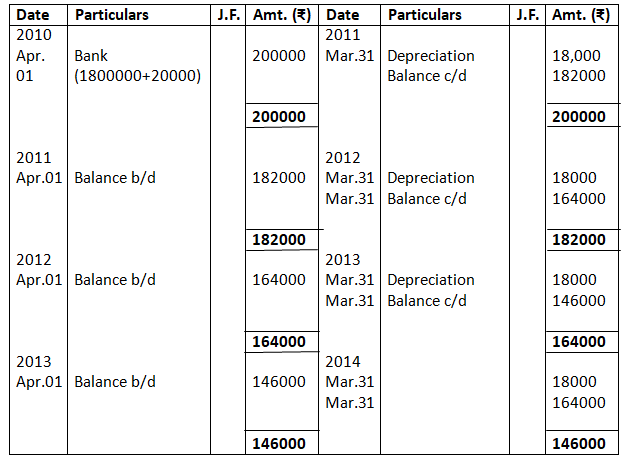
Working notes: Calculation of annual depreciation
Depreciation (p.a.) = (Original cost – Scrap Value)/Estimated life of Asset (year)
= (180000 + 10000 + 10000 – 20000 / 10
= Rs.18000 per annum
Dr. Depreciation Account Cr.
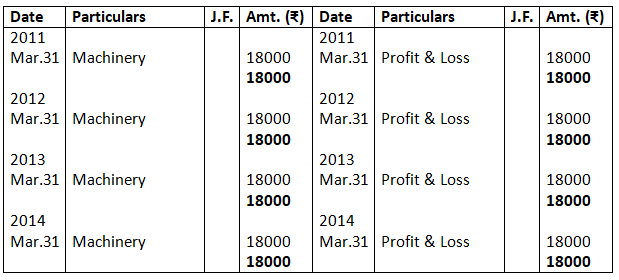
(b)
Dr. Books of Bajrang Marbles Machinery A/c Cr.
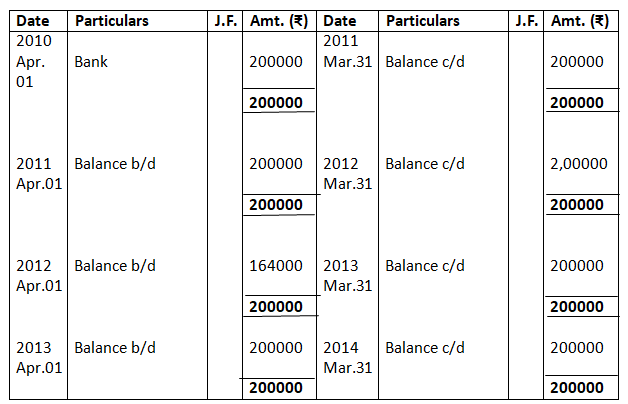
Dr. Provision for Depreciation A/c Cr.
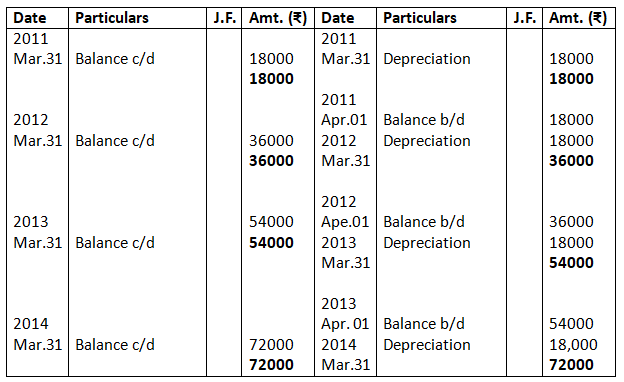
Dr. Depreciation A/c Cr.
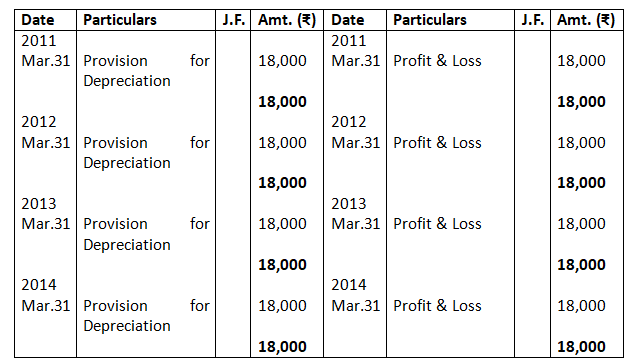
2. On July 01, 2010, Ashok Ltd. Purchased a Machine for Rs.1,08,000 and spent Rs.12,000 on its installation. At the time of purchase it was estimated that the effective commercial life of the machine will be 12 years and after 12 years its salvage value will be Rs.12,000.
Prepare machine account and depreciation Account in the books of Ashok Ltd. For first three years, if depreciation is written off according to straight line method. The account are closed on December 31st, every year.
Solution:-
Dr. Books of Ashok Ltd. Machinery A/c Cr.
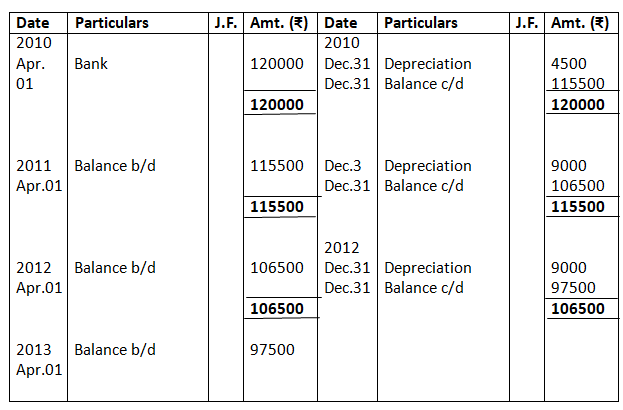
Dr. Depreciation A/c Cr.
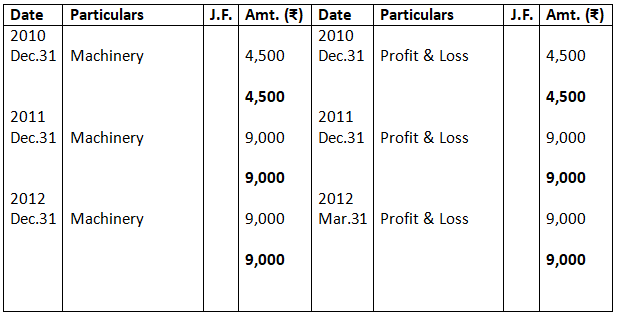
Working Note:
Calculation of annual depreciation
Depreciation (p.a.) = (108000 + 12000 – 12000) /12 years
= Rs.9,000 per annum
3. Reliance Ltd. Purchased a second hand machine for Rs.56,000 on October 01, 2011 and spent Rs.28,000 on its overhaul and installation before putting it to operation. It is expected that the machine can be sold for Rs.6,000 at the end of its useful life of 15 years. Moreover an estimated cost of rS.1,000 is expected to be incurred to recover the salvage value of Rs.6, 000. Prepare machine account and Provision for depreciation account for the first three years charging depreciation by fixed installment Method. Accounts are closed on March 31, every year.
Solution:-
Dr. Books of Reliance Ltd. Machinery A/c Cr.
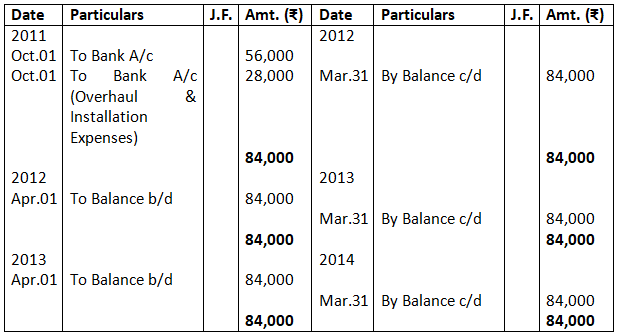
Dr. Provision for Depreciation A/c Cr.
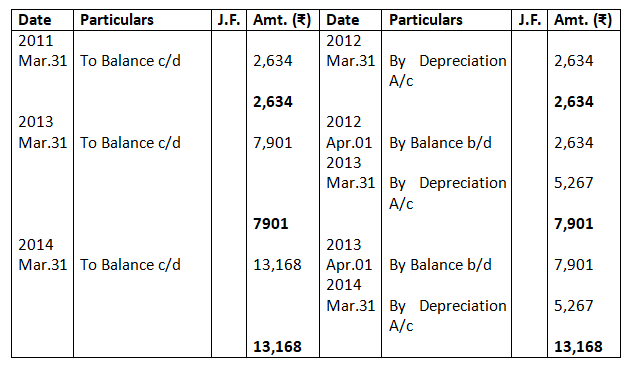
Working Note:-
- Net Residual value = Sale value – Expenses incurred for the disposal of the Asset
= 6,000 – 1,000
= 5,000
B. Cost of asset = 56,000 + 28,000
= 84,000
C. Yearly Depreciation = cost of asset – estimated residential Value / Estimated useful life of the asset
= 84,000 – 5,000 / 15
= 79,000 / 15
= 5,267
4. Berlia Ltd. Purchased a second hand machine for Rs.56,000 on July 01, 2015 and spent Rs.24,000 on its repair and installation and Rs.5,000 for its carriage. On September 01, 2016, it purchased another machine for Rs.2,50,000 and spent Rs.10,000 on its installation.
- Depreciation is provided on machinery @ 10% p.a. on original cost method annually on December 31. Prepare machinery account and depreciation account from the year 2015 to 2018.
- Prepare machinery account and depreciation account from the year 2011 to 2018, if depreciation is provided on machinery @ 10% p.a. on written down value method annually on December 31.
Solution:- (a)
Books of Berlia Ltd.
Dr. Machinery Account (Original cost method) Cr.
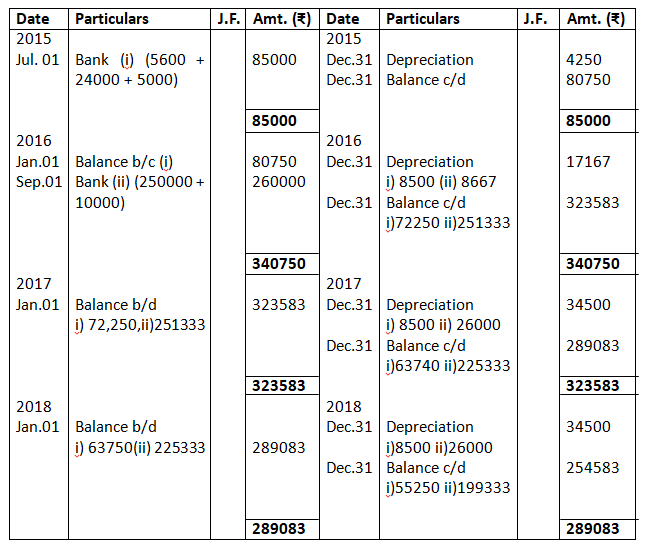
Dr. Depreciation Account Cr.
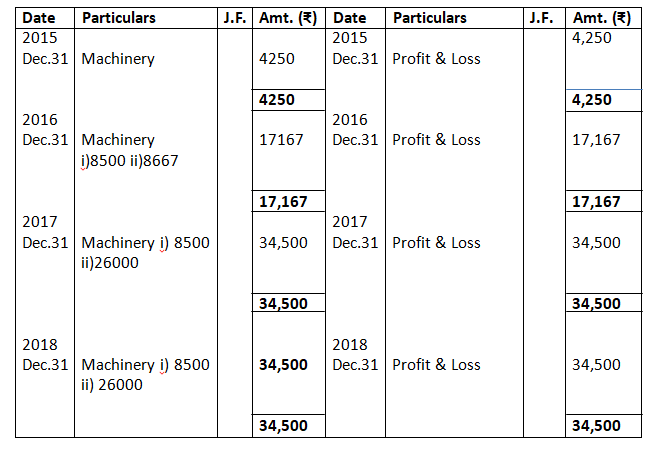
Working Notes:
Calculation of annual depreciation
Depreciation (p.a.) on Machinery Purchased on July 01, 2015
= (56,000 + 24,000 + 5,000) x 10 / 100
= Rs.8,500 per annum
Depreciation (p.a.) on Machinery purchased on September 01, 2016.
= (2,50,000 + 10,000) x 10 / 100
= Rs.26,000 per annum
(b)
Books of Berlia Ltd.
Dr. Machinery Account (Written Down Value method) Cr.
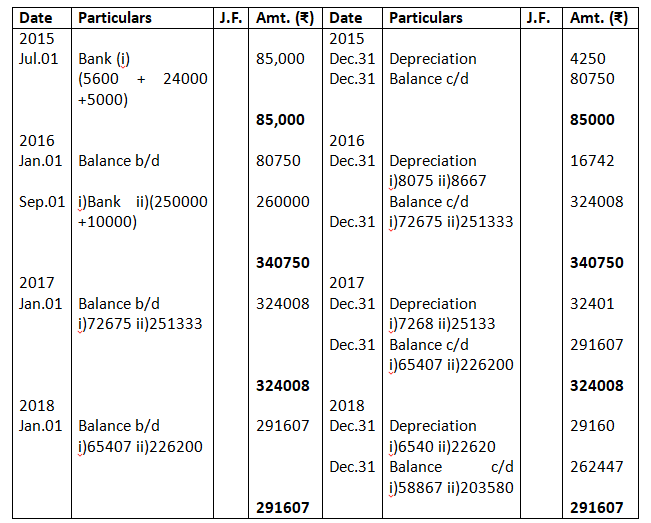
5. Ganga Ltd. Purchased a machinery on January 01, 2014 for Rs.5,50,000 and spent Rs.50,000 on its installation. On September 01, 2014 it purchased another machine for Rs.3,70,000. On May 01, 2015 it purchased another machine for Rs.8,40,000 (including installation expenses).
Depreciation was provided on machinery @ 10% p.a. on original cost method annually on December 31, Prepare:
- Machinery account and depreciation account for the years 2014, 2015, 2016 and 2017.
- If depreciation is accumulated in provision for Depreciation account then prepare machine account and provision for depreciation account for the years 2014, 2015, 2016 and 2017.
Solution:- a)
Books of Ganga Ltd.
Dr. Machinery Account Cr.
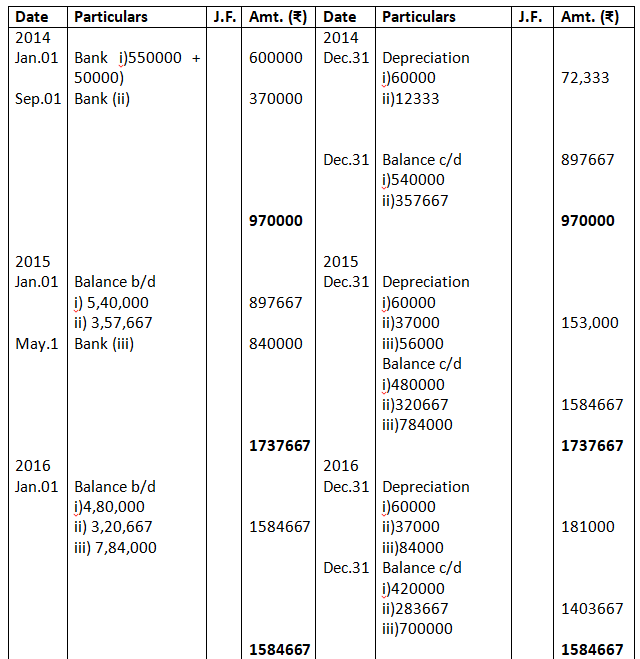
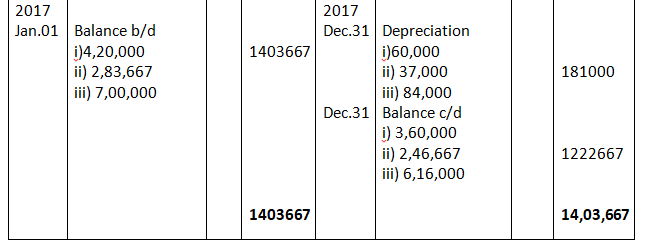
Dr. Depreciation Account Cr.
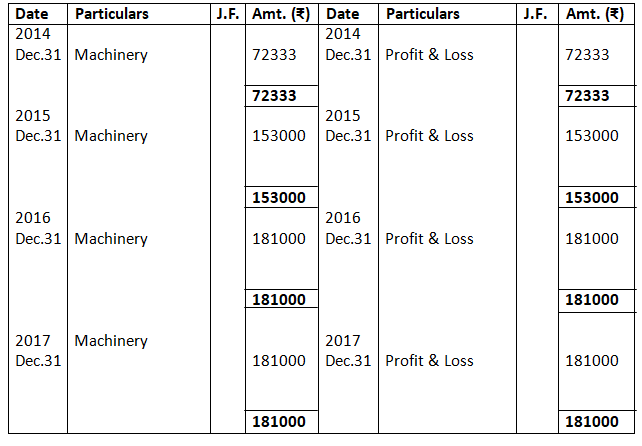
Books of Ganga Ltd.
Dr. Machinery Account Cr.
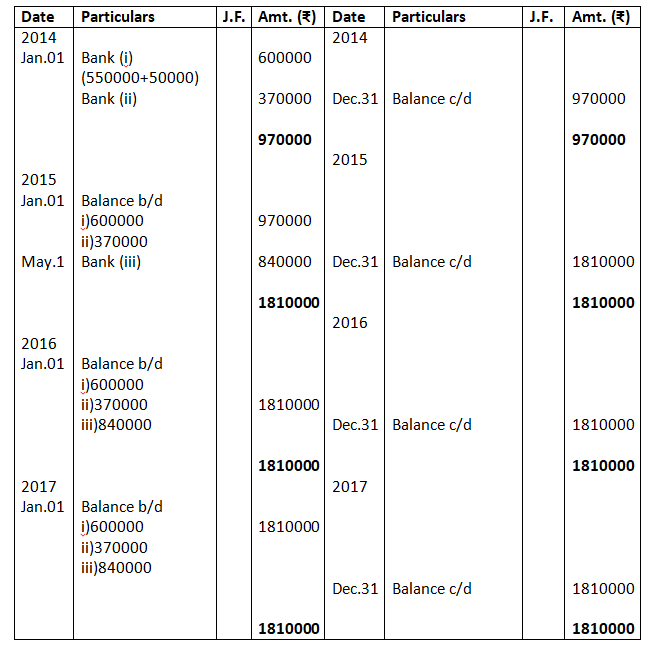
Dr. Provision for Depreciation Account Cr.
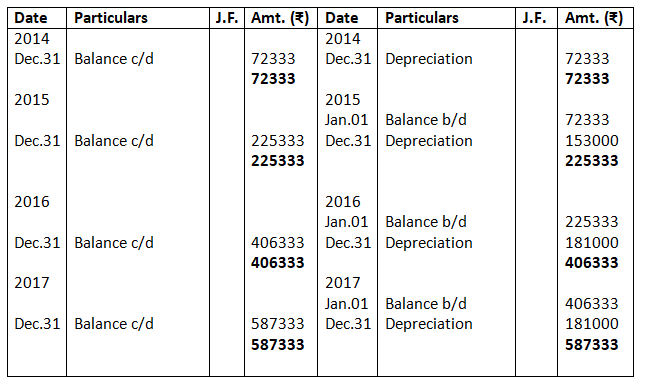
6. Azad Ltd. Purchased furniture on October 01, 2014 for Rs.4,50,000. On March 01, 2015 it purchased another furniture for Rs.3,00,000. On July 01, 2016 it sold off the first furniture purchased in 2014 for Rs.2,25,000. Depreciation is provided at 15% p.a. on written down value method each year. Accounts are closed each year on March 31. Prepare furniture account, and accumulated and March 31, 2017. Also give the above two accounts if furniture disposal account is opened.
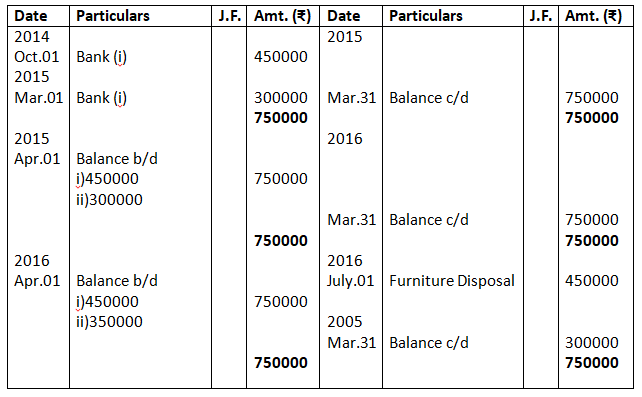
Dr. Accumulated Depreciation Account Cr.
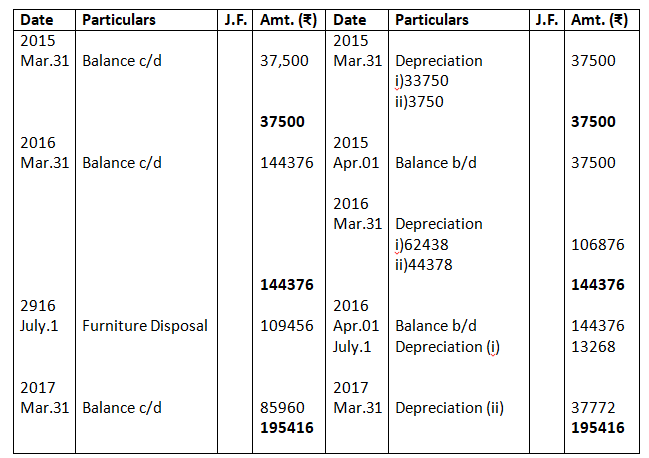
Dr. Furniture Disposal Account Cr.

Working Note:
Furniture (i)
Year Opening Balance – Depreciation = Closing Balance
2014-15 450000 – 33750 = 416250
2015-16 416250 – 62438 = 353812
2016 353812 – 13268 ( 3 months) = 340544
Balance on July 01, 2016 = 340544
Less: Sale on July 01, 2016 = (225000)
Loss on sale of furniture = 115544
7. M/s Lokesh Fabrics purchased a Textile Machine on April 01, 2011 for Rs.1,00,000. On July 01, 2012 another machine costing Rs.2,50,000 was purchased. The machine purchased on April 01, 2011 was sold for Rs.25,000 on October 01, 2015. The company charges depreciation @ 15% p.a. on straight line method. Prepare machinery account and machinery disposal account for the year ended March 31, 2016.
Solution:-
Books of M/s. Lokesh Fabrics
Dr. Machinery Account Cr.
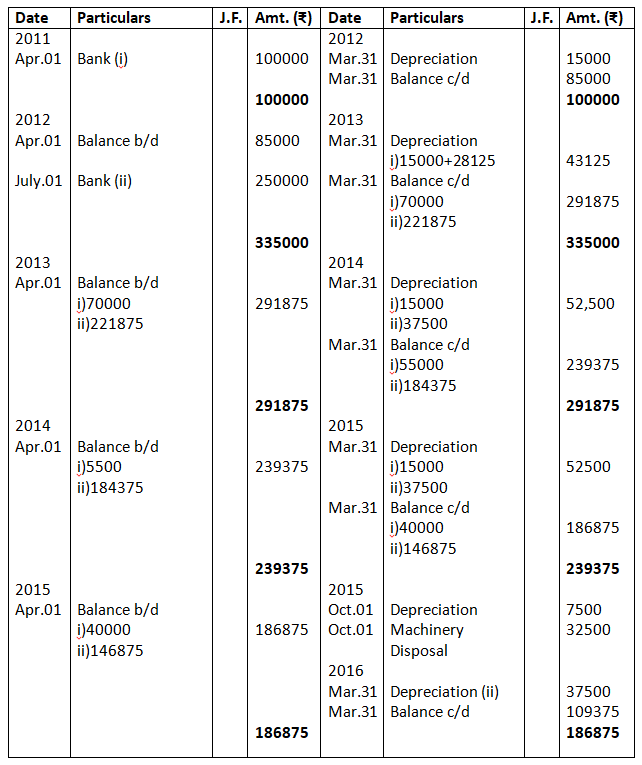
Dr. Machinery Disposal Account Cr.

8. The following balances appear in the books of Crystal Ltd. On Jan 01, 2015
Machinery account on Rs.15,00,000
Provision for depreciation account Rs.5,50,000
On April 01, 2015 a machinery which was purchased on January 01, 2012 for Rs.2,00,000 was sold for Rs.75,000. A new machine was purchased on July 01, 2015 for Rs.6,00,000. Depreciation is provided on machinery at 20% p.a. on Straight line method and books are closed on December 31 every year. Prepare the machinery account and provision for depreciation account for the year ending December 31, 2015.
Solution:-
Dr. Machinery Account Cr.

Dr. Provision for Depreciation Account Cr.
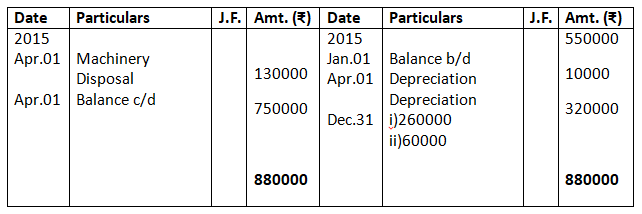
Working Note:-
Machine Sold on July 01, 2015
Years Opening Balance Depreciation Closing Balance
2012 2,00,000 – 40,000 = 1,60,000
2013 1,60,000 – 40,000 = 1,20,000
2014 1,20,000 – 40,000 = 80,000
2015 80,000 – 10,000 = 70,000
Accumulated Depreciation = 1,30,000
Value on April 01,2015 = (70,000)
Less: Sale = 75,000
Profit on sale of Machinery = 5,000
Dr. Machinery Disposal Account Cr.

9. M/s. Excel Computers has a debit balance of Rs.50,000 (original cost Rs.1,20,000) in computers account on April 01, 2010. On July 01, 2010 it purchased another computer costing Rs.2,50,000. One more computer was purchased on January 01, 2011 for Rs.30,000. On April 01, 2014 the computer which has purchased on July 01, 2010 became obsolete and was sold for Rs.20,000. A new version of the IBM computer was purchased on August 01, 2014 for Rs.80,000. Show Computers account in the books of Excel Computers for the years ended on March 31, 2011, 2012, 2013, 2014 and 2015. The computer is depreciated @ 10 p.a. on straight line method basis.
Solution:-
Books of M/s Excel Computers
Dr. Computer Account Cr.
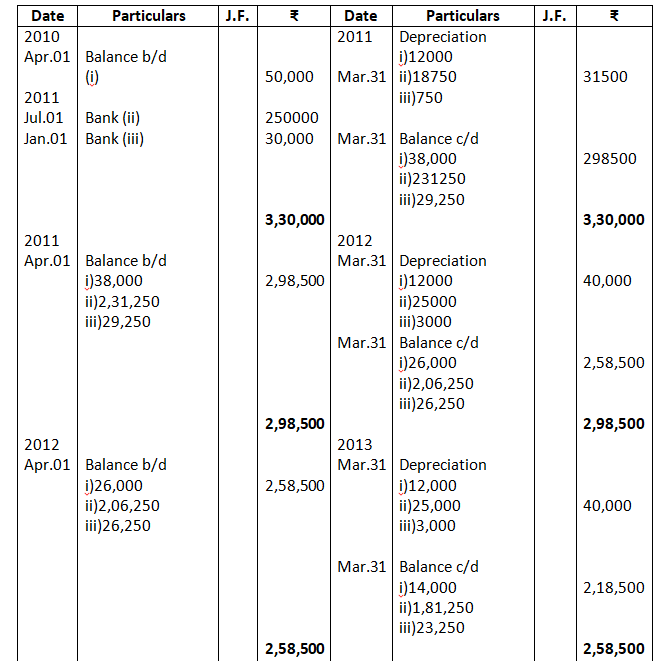
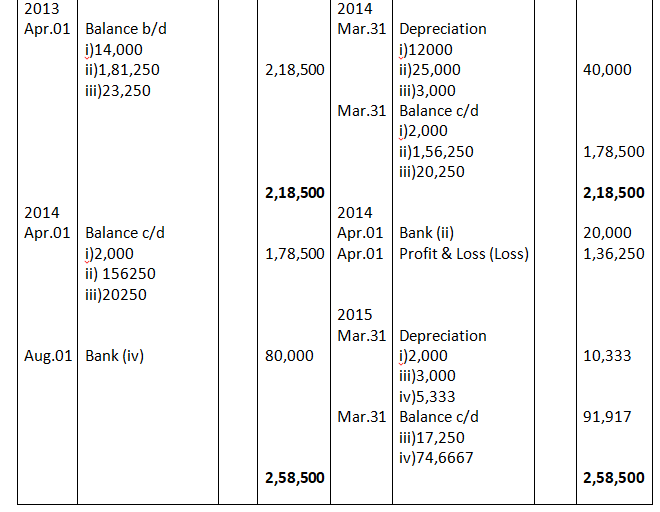
Note:
As per the solution, the closing balance, as on 31st March, 2005 is Rs.91,917; however, as per the book it is Rs.83,917.
10. Carriage Transport Company purchased 5 trucks at the cost of Rs.2,00,000 each on April 01, 2011. The company writes off depreciation @ 20% p.a. on original cost and closes its books on December 31, every year. On October 01, 2013, one of the trucks is involved in an accident and is completely destroyed. Insurance company had agreed to pay Rs.70,000 in full settlement of the claim. On the same date the company purchased a second hand truck for rs.1,00,000 and spent Rs.20,000 on its overhauling. Prepare truck account and provision for depreciation account for the three years ended on December 31, 2013. Also give truck account if truck disposal account is prepared.
Solution:-
Books of Carriage Transport Company
Dr. Truck Account Cr.
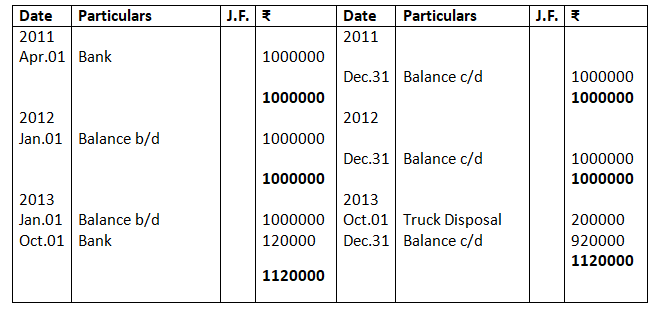
Dr. Provision for Depreciation Account Cr.
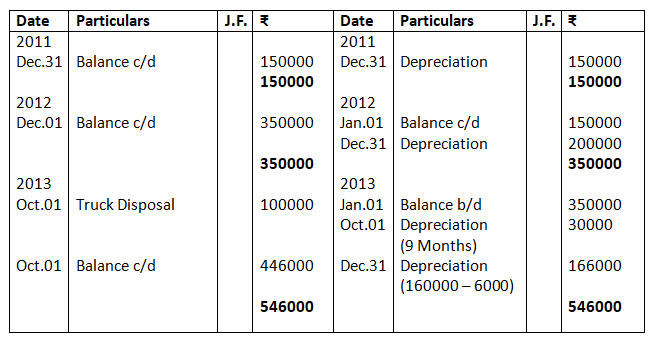
Dr. Truck Disposal Account Cr.

Working Note:
Truck involved in accident
Year Opening Balance – Depreciation = Closing Balance
Apr.01, 2011 2,00,000 – 30,000 = 170,000
Jan.01, 2012 1,70,000 – 40,000 = 1,30,000
Jan.01, 2013 1,30,000 – 30,000 = 1,00,000
Accumulated Depreciation = 1,00,000
Value on Oct.01, 2013 = 1,00,000
Less: Insurance Claim = 70,000
Loss on Accident = 30,000
11. Saraswati Ltd. Purchased a machinery costing rs.10,00,000 on January 01, 2011. A new machinery was purchased on 01 May, 2012 for Rs.15,00,000 and another on July 01, 2014 for Rs.12,00,000. A part of the machinery which originally cost Rs.2,00,000 in 2011 was sold for rs.75,000 on April 30, 2014. Show the machinery account, provision for depreciation account and machinery disposal account from 2011 to 2015 if depreciation is provided at 10% p.a. on original cost and account are closed on December 31, every year.
Solution:-
Books of Saraswati Ltd.
Dr. Machinery Account Cr.
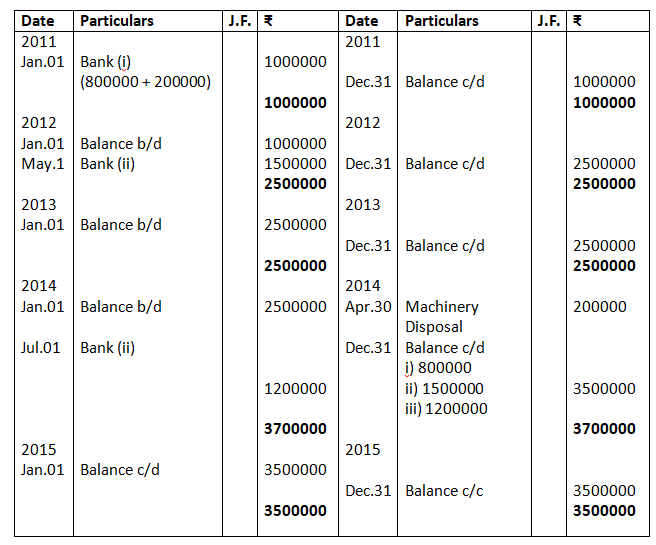
Dr. Provision for Depreciation Account Cr.
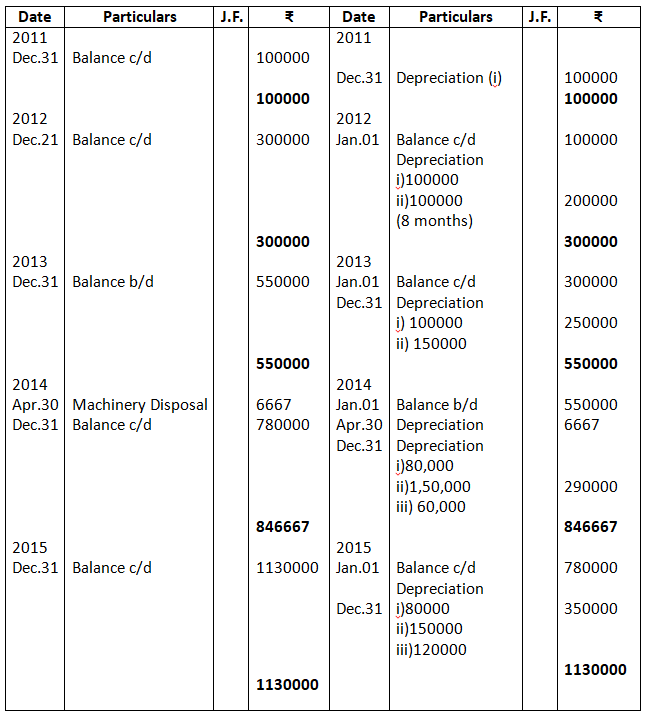
Dr. Machinery Disposal Account Cr.

Working Note:
Year Opening Balance – Depreciation Closing Balance
2011 2,00,000 – 20,000 = 180,000
2012 180000 – 20000 = 160000
2013 160000 – 20000 = 140000
2014 140000 – 6667 = 133333
Accumulated Depreciation = 66667
Value on Apr.30, 2014 = 133,333
Sale on Apr.30, 2014 = -75000
Loss on sale = 58333
12. On July 01, 2011 Ashwani purchased a machine for Rs.2,00,000 on credit. Installation expenses Rs.25,000 are paid by cheque. The estimated life is 5 years and its scrap value after 5 years will be Rs.20,000. Depreciation is to be charged on straight line basis. Show the journal entry for the year 2011 and prepare necessary ledger accounts for first three years.
Solution:-
Books of Ashwani
Journal
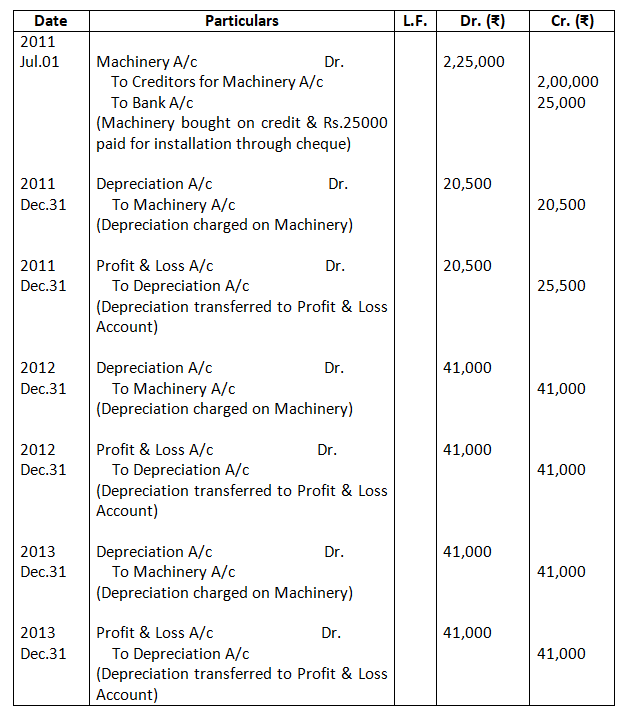
Dr. Ledger Machinery Account Cr.
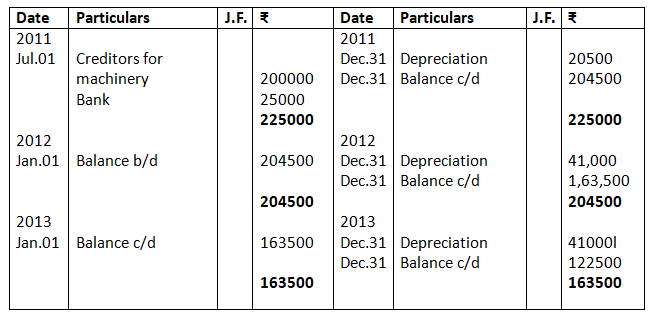
Working Note:
Calculation of annual depreciation
Depreciation (p.a.) = (200000 + 25000 – 20000) / 5
= Rs.41,000 per annum
13. On October 01, 2010, a Truck was purchased for Rs.8,00,000 by Laxmi Transport Ltd. Depreciation was provided at 15% p.a. on the diminishing balance basis on this truck. On December 31, 2013 this Truck was sold for Rs.5,00,000. Accounts are closed on 31st March every year. Prepare a Truck Account for the four years.
Solution:-
Books of Laxmi Transport Ltd.
Dr. Truck Account Cr.
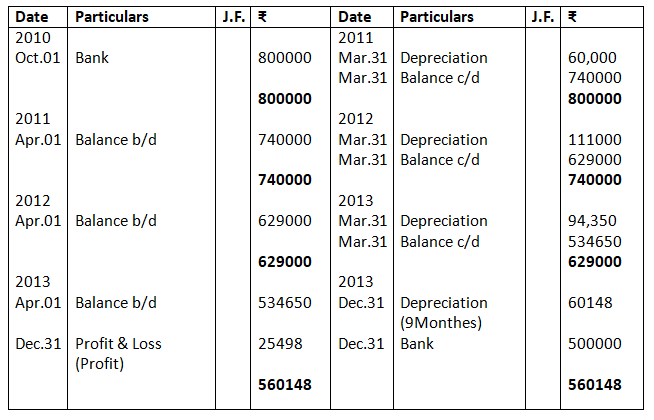
Note:
As per the solution, the profit on the sale of truck, as on December 31, 2013 is Rs.25498; however, the answer given in the book is Rs.58,237.
14. Kapil Ltd. Purchased a machinery on July 01, 2011 for Rs.3,50,000. It purchased two additional machines, on April 01, 2012 costing Rs.1,50,000 and on October 01, 2012 costing Rs.1,00,000. Depreciation is provided @ 10% p.a. on straight line basis. ON January 01, 2013, first machinery become useless due to technical changes. This machinery was sold for Rs.1,00,000. Prepare machinery account for 4 years on the basis of calendar year.
Solution:-
Books of Kapil Ltd
Dr. Machinery Account Cr.
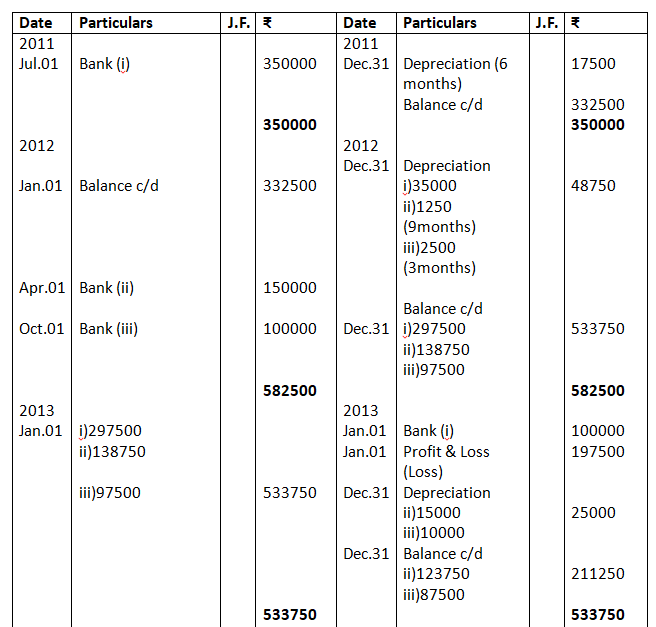
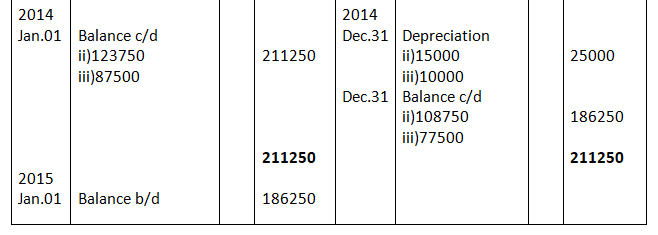
Working Note:
Profit or Loss on Sale of Part of Truck:
Year Opening Balance Depreciation Closing Balance
2010-2011 8,00,000 – 60,000 (6 months) = 740000
2011-2012 7,40,000 – 1,11,000 = 629,000
2012-2013 629,000 – 94,350 (9 month) = 5,34,650
2013-2014 5,34,650 – 60,148 (9 month) = 4,74,502
WDV as on Dec. 31, 2013 = 4,75,502
Less: Sales on Dec.31, 2013 = 5,00,000
Profit on sale = 25498
15. On January 01, 2011, Satkar Transport Ltd., purchased 3 buses for Rs.10,00,000 each. On July 01, 2013 one bus was involved in an accident and was completely destroyed and Rs.7,00,000 were received from the Insurance Company in full settlement. Depreciation is written off @ 15% p.a. on diminishing balance method. Prepare bus account from 2011 to 20114. Books are closed on December 31 every year.
Solution:-
Books of Satkar Transport Ltd.
Dr. Bus Account Cr.
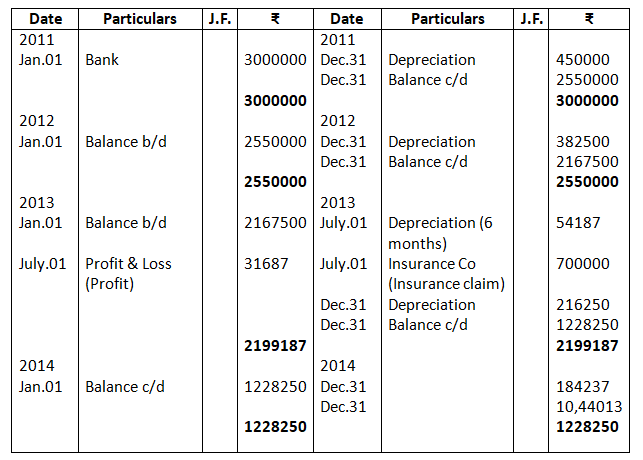
16.On October 01, 2011 Juneja Transport Company purchased 2 Trucks for Rs.10,00,000 each. On July 01, 2013, One Truck was involved in an accident and was completely destroyed and Rs.6,00,000 were received from the insurance company in full settlement. On December 31, 2013 another truck was involved in an accident and destroyed partially, which was not insured. It was sold off for Rs.1,50,000. On January 31, 2014 company purchased a fresh truck for Rs.12,00,000. Depreciation is to be provided at 10% p.a. on the written down value every year. The books are closed every year on March 31. Give the truck account from 2011 to 2014.
Solution:-
Books of Juneja Transport Company
Dr. Truck Account Cr.
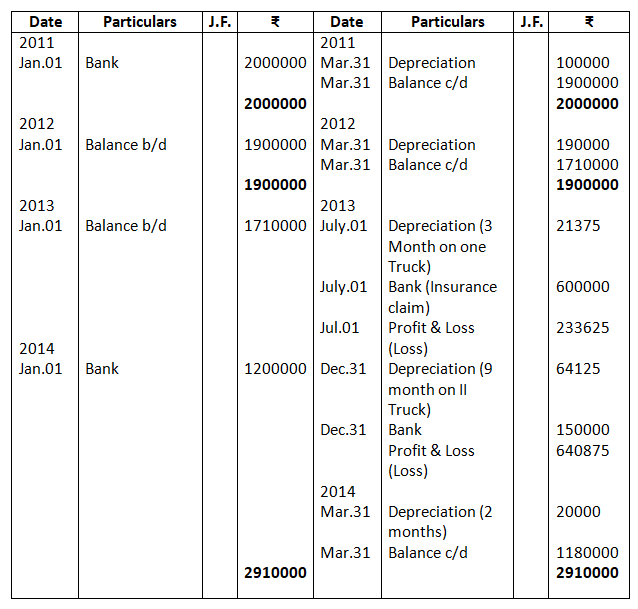
Note:-
As per solution, loss on truck one is as Rs.2,33,625; however, as per NCERT book, loss is of Rs.3,26,250.
Truck – 1
Year Opening Balance – Depreciation = Closing Balance
Oct.01, 2011 10,00,000 – 50,000 (6 Months) = 9,50,000
Apr.01, 2012 9,50,000 – 95,000 = 8,55,000
Apr.01, 2013 8,55,000 – 21,375 (3 Months) = 8,33,625
Value on July 01, 2013 = 8,33,625
Insurance Claim = -6,00,000
Loss on Truck – 1 = Rs.2,33,625
Truck – 2
Year Opening Balance – Depreciation = Closing Balance
Oct.01, 2012 10,00,000 – 50,000 (6 Months) = 9,50,000
Apr.01, 2012 9,50,000 – 95,000 = 8,55,000
Apr.01, 2013 8,55,000 – 64,125 (9 Months) = 7,90,875
Value on Dec.31, 2013 = 7,90,875
Insurance Claim = -1,50,000
Loss on Truck – 2 = Rs.6,40,875
17. A Noida based Construction company owns 5 cranes and the value of this asset in its books on April 01, 2017 is Rs.40,00,000. On October 01, 2017 it sold one of its cranes whose value was Rs.5,00,000 on April 01, 2017 at a 10% profit. On the same day it purchased 2 cranes for Rs.4,50,000 each.
Prepare cranes account. It closes the book on December 31 and provides for depreciation on 10% written down value.
Solution:-
Dr. Cranes Account Cr.
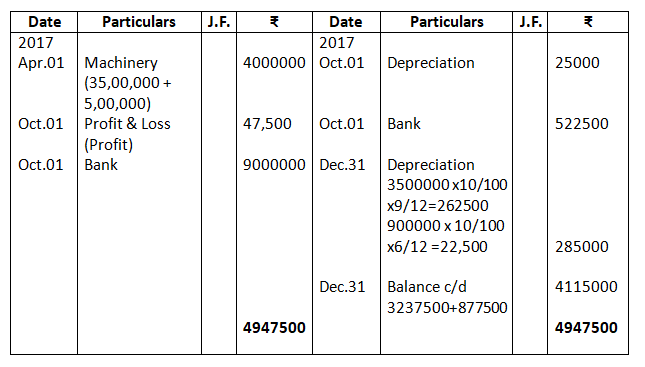
18. Shri Krishan Manufacturing Company purchased 10 machines for Rs.75,000 each on July 01, 2016, one of the machines got destroyed by fire and an insurance claim of Rs.45,000 was admitted by the company. On the same date another machine is purchased by the company for Rs.1,25,000. The company writes off 15% p.a. depreciation on written down value basis. The company maintains the calendar year as its financial year. Prepare the machinery account from 2014 to 2017.
Solution:-
Books of Shri Krishna Manufacturing Company
Dr. Machinery Account Cr.
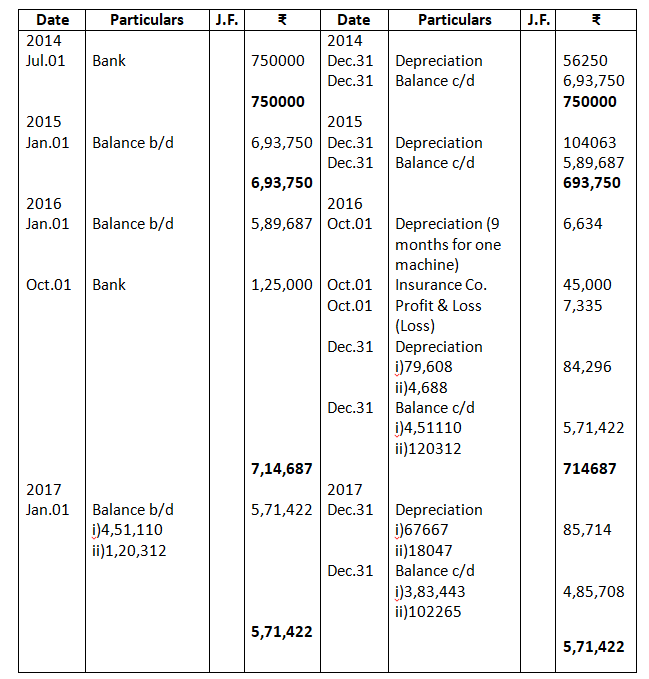
Working Note:
Machine Costing Rs.75,000 sold on Oct.01, 2002
Year Opening Balance – Depreciation = Closing Balance
Jul.01, 2014 75,000 – 5,625 (6 months) = 69,375
Jan.01, 2015 69,375 – 10,406 = 58,969
Jan.01, 2016 58,969 – 6,634 = 52,335
Value on Oct.01,2016 = 52,335
Insurance Claim = – 45,000
Loss = Rs.7,335
19. On January 01, 2014, a Limited company purchased machinery for Rs.20,00,000. Depreciation is provided @ 15% p.a. on diminishing balance method. On March 01, 2016, one fourth of machinery was damaged by fire and Rs.40,000 were received from the insurance company in full settlement. On September 01, 2016 another machinery was purchased by the company for Rs.15,00,000. Write up the machinery account from 2010 to 2013. Books are closed on December 31, every year.
Solution:-
Dr. Machinery Account Cr.
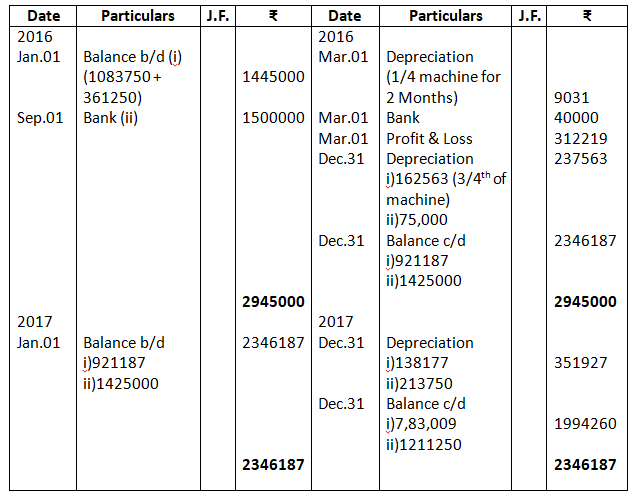
Working Note:
Machine (i)
Years January 01 Depreciation (15% p.a.) = Closing Balance
2014 20,00,000 – 3,00,000 = 17,00,000
2015 17,00,000 – 2,55,000 = 14,45,000
2016 14,45,000
1/4th of Machine (i)
Years January 01 Depreciation (15% p.a.) = Closing Balance
2014 5,00,000 – 75,000 = 4,25,000
2015 4,25,000 – 63,750 = 3,61,250
2016 3,61,250 – 9,031 (2 months) = 3,52,219
Value on 1 Mar.2016 = 3,52,219
Insurance Claim = 40,000
Loss = Rs.3,12,219
20. A Plant was purchased on 1st July, 2015 at a cost of Rs.3,00,000 and Rs.50,000 were spent on its installation. The depreciation is written off at 15% p.a. on the straight line method. The plant was sold for Rs.1,50,000 on October 01, 2017 and on the same date a new Plant was installed at the cost of Rs.4,00,000 including purchasing value. The accounts are closed on December 31 every year. Show the machinery account and provision for depreciation account for 3 years.
Solution:-
Dr. Plant Account Cr.
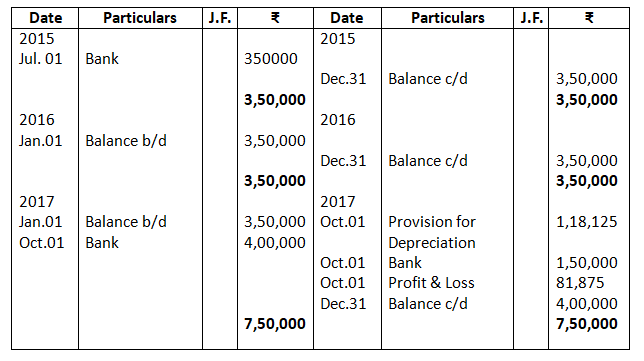
Dr. Provision for Depreciation Account Cr.
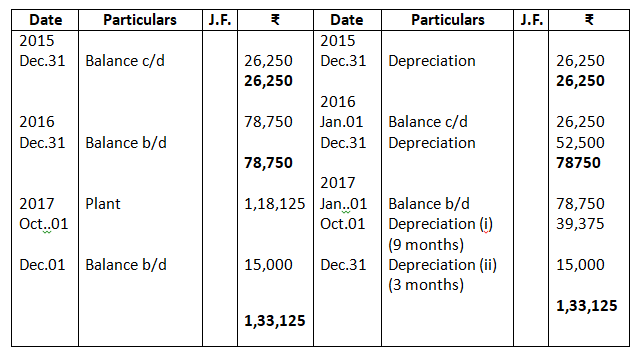
21. An extract of Trial balance from the books of Tahiliani and Sons Enterprises on March 31, 2017 is given below:

Additional Information:
Bad Debts proved bad but not recorded amounted to Rs.2,000.
Provision is to be maintained at 8% of Debtors.
Give necessary accounting entries for writing off the bad debts and creating the provision for doubtful debts account. Also show the necessary accounts.
Solution:-
Journal
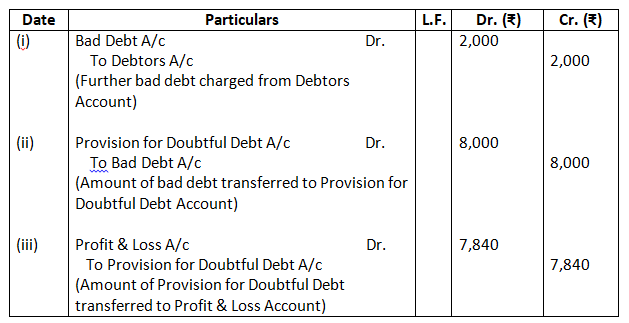
Dr. Bad Debt Account Cr.

Dr. Debtors Account Cr.

Dr. Provision for Doubtful Debts Account Cr.

22. The following information are extract from the Trial Balance of M/s Nisha traders on 31 March 2017.
Sundry Debtors 80,500
Bad debts 1,000
Provision for bad debts 5,000
Additional Information
Bad Debts 500
Provision is to be maintained at 2% of Debtors.
Prepare bad debts account, provision of bad debts account and profit and loss account.
Solution:-
Dr. Bad Debt Account Cr.

Dr. Provision for Bad debt Account Cr.

Dr. Profit & Loss Account Cr.
